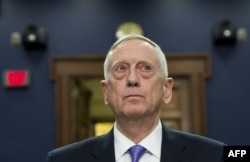WASHINGTON -- U.S. Defense Secretary Jim Mattis says President Donald Trump has given him the authority to establish troop levels in Afghanistan but that the president has not given him "carte blanche" to set strategy in the war-torn country.
Speaking on June 15 before the House Appropriations Committee, Mattis also said that "we're not looking at a purely military strategy" and that the U.S. effort must be one that leads to "reconciliation," without elaborating.
Mattis repeated what he told a Senate panel a day earlier, that he would present a new military strategy for Afghanistan to the president within weeks, including an adjusted troop number.
Before the House panel, he said Trump "has delegated details of the forces that will be allocated to support what he approves as a strategy."
"But I assure you this is not a carte blanche for me to come up with numbers that are going into this interagency, foreign-policy-led effort."
He said the president "maintains strategic oversight, he is an actively engaged, a very hard questioner about what the strategy is."
After his comments before the Senate panel, some critics had expressed concerns that Trump had handed over too much authority to the military to set strategy in Afghanistan.
Mattis declined to answer directly when asked how long U.S. troops would be engaged in Afghanistan or what would constitute a "victory" in the conflict.
"As far as what it is we would be doing to bring this to a better conclusion, we've got to recognize that we tried to leave the Afghan forces before they were fully mature, without the sufficient air support that would allow them to hold the high ground."
He said future strategy would need to "marry itself to reality," one that does not "add to [Afghan forces'] responsibility without preparing them for success. If that means we have to keep advisers with them a little longer...we will do so."
He also said the United States must "work hard" on anticorruption efforts "to make this [Afghan] government more responsive to its people.... We're not looking at a purely military strategy."
He repeated his earlier comments that the new U.S. strategy would take a "regional approach" rather than looking at Afghanistan in "isolation."
Mattis on June 13 acknowledged that the United States was "not winning" the 16-year war in Afghanistan amid a surge by Taliban militants seeking to regain power in the country.
Some outside governments, including Russia's, have urged national reconciliation to include the Taliban to restore stability in the country.
U.S.-led forces invaded Afghanistan at the end of 2001 to oust the Taliban government, which was accused of sheltering Al-Qaeda militants blamed for carrying out the September 11, 2001, terrorist attacks in the United States.
The United States has about 8,400 troops in Afghanistan, and army officials on the ground have told Congress that they could use an infusion of forces to bolster support for the Afghan National Army.
U.S. media have reported that the defense secretary will recommend sending another 3,000-5,000 U.S. troops to break what he has called a "stalemate" between U.S.-backed government forces and the Taliban.








